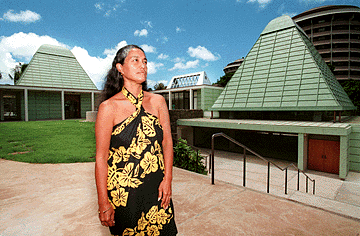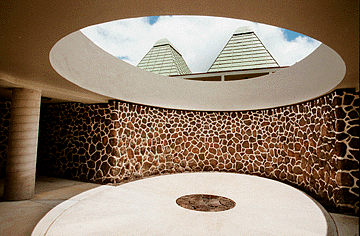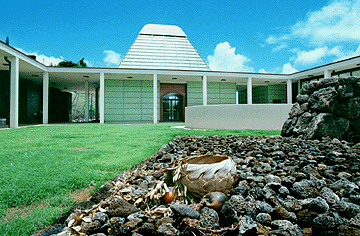
The Center for Hawaiian Studies "is designed with the natural elements of Hawaii," says director Haunani-Kay Trask.

The Center for Hawaiian Studies "is designed with the natural elements of Hawaii," says director Haunani-Kay Trask.
"For me, the most exciting thing is that future graduates, future Hawaiians, will benefit," the 24-year-old Kinilau said.
Surrounded by massive moss-rock walls, native plants and topped with four conical roofs, the controversial $7.5 million center opens to University of Hawaii students Aug. 26 after more than a year in delays.
The two-story, U-shaped structure - bordered by Manoa Stream, Kanewai Cultural Garden and Dole Street - boasts a resource room, a computer lab, seminar and conference rooms and two large classrooms with optional wall-sized doors for open-air activities.
It also has a 48-seat lecture hall, a 150-seat open-air auditorium overlooking the three-acre garden, graduate and faculty offices, a faculty lounge as well as a student services wing with private study rooms, carols and project offices.
Moreover, the center's upper courtyard serves as a burial site for the remains of 18 skeletons, believed to be pre-contact Hawaiians, unearthed during water main work on Dole Street. The remains were reinterred last year using a traditional rock wall burial vault, adding a spiritual aspect to the only stand-alone Hawaiian Studies building in the world, says center Director Haunani-Kay Trask.

The Kamakakuokalani, or "Upright Eye of Heaven" offers a display area for art.
Trask says such commitment by the state and UH for a surging Hawaiian studies program tells the 200,000 native and part-Hawaiians around today they as well as na mea Hawaii - things Hawaiian - are important.
"The beauty of it to me tells a lot," Trask said. "It's designed to recall Hawaiian architecture instead of those closed buildings with little cubbyhole windows that are just practical."
Edgar A. Porter, acting associate dean within the School of Hawaiian, Asian and Pacific Studies, said the building is a marvelous presence that raises public awareness of the school.
"When I go through the building . . . the thing I appreciate the most is how it all comes together, how it's so inclusive and everybody's taken care of," Porter said.
"It's all there. It's such a wonderful holistic educational structure that its a delight to go down there and walk around," he said.
But for those within the school, getting the center built was a seven-year ordeal marred in dispute over taro patches, or lo'i kalo, that had to be temporarily removed so work on the building's student services wing could be completed.
In February 1992, Ho'okahe Wai Ho'oulu 'Aina, a group aimed at preserving Kanewai Cultural Garden, filed a lawsuit against the university to block construction because it claimed the student wing damaged historic sites, threatened endangered plants and violated various laws protecting water quality.

An offering of ho'okupu is left at a burial mound, or puuhonua, which contains the remains of 18 Hawaiians believed to predate Western contact.
Paul Nahoa Lucas, president of Ho'okahe and a staff attorney at the Native Hawaiian Legal Corp., said the group's position has not changed since then and that a third of the 1.7-acre lo'i was destroyed in construction. A proposal to allow the group access to the garden - now under control of the Center for Hawaiian Studies - was not acceptable, he said.
Lucas was among several Hawaiian studies students in 1980 who cleared the low-lying area between Manoa Stream and Dole Street and started a series of stream-fed taro plantings. The group claims the area was in continuous cultivation from ancient times until a farmer on a month-to-month lease let it lapse in the 1970s.
"It's been destroyed and it is sad that the institution that's supposed to uphold the Hawaiian language and culture is the perpetrator," said Lucas, who added he was disillusioned with the way problems are resolved at the university. Trask, however, maintains the building did not destroy any historic sites and pointed to two rows of taro patches in the garden today that will allow the center to hold courses in taro cultivation.
Besides the lawsuit, other delays in construction reported by UH were adverse site conditions during excavation; redesign of certain project features; relocation of a 20-inch waterline; additional landscaping along Dole Street; construction of a fire lane; and an archeological survey.
The Center for Hawaiian Studies needs more faculty, graduate instructors and student helpers to meet the growing popularity of its courses.Edgar A. Porter, associate acting dean of the School of Hawaiian, Asian and Pacific Studies, said that of the nearly 300 students majoring in the School of Hawaiian, Asian and Pacific Studies, more than a third are in Hawaiian studies.
"It has such an unique and singular mission that's different from the other programs," Porter said.
Center officials added the hundreds of other University of Hawaii students who take Hawaiian classes but don't major in Hawaiian studies created the need for more faculty. Director Haunani-Kay Trask points out the center has gone from one part-time position offering a single course to 13 students in 1986 to four full-time faculty offering 14 courses to 1,350 enrolled students in 1996.
Trask added that 52 percent of student enrollment in the school today is in Hawaiian studies, meaning the center is serving far more students than it's supposed to based on the size of its faculty.
Eventually, Trask hopes to offer master's and doctorate degrees in Hawaiian studies.
"Our goal is to reverse the underrepresentation and under-achievement of Hawaiians on campus by providing them with mentoring, native role models and a course of study which emphasizes Hawaiian history, culture, and politics from the Hawaiian point of view," she said.